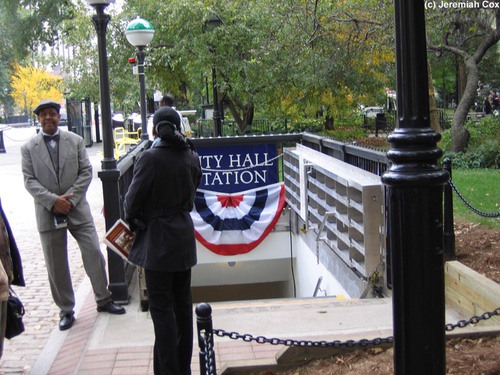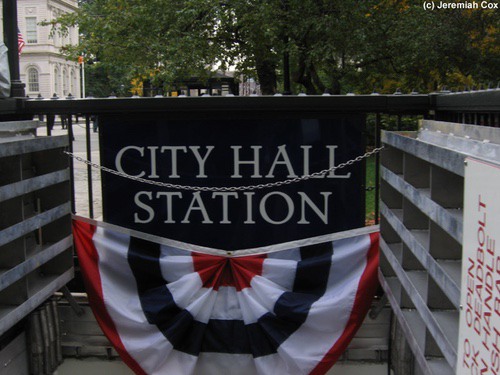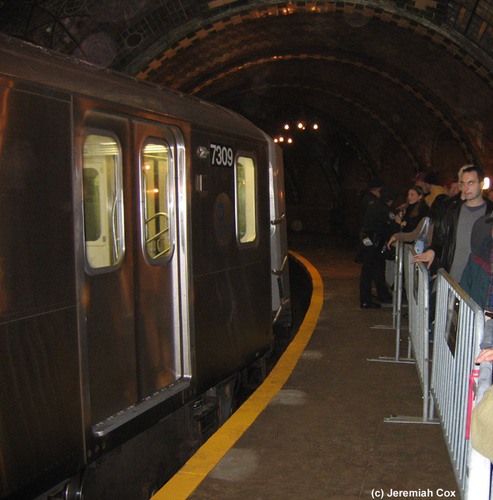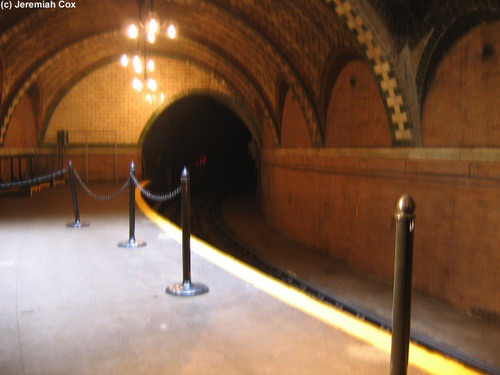



City Hall Loop Station was the first (underground) subway station to open; it was where the ceremonial first ride of the subway began on opening day October 27, 1904 and was the first subway station to close on December 31, 1945. The reasons for its closure include the fact it is just 700 feet from the Brooklyn Bridge Station, along with the steep curve of the single-track station is located on. The stop, as the name implies is on one of the 2 to 3 (depending upon how South Ferry is counted) balloon loops on the subway. The other one is the Inner and Outer loop of South Ferry. The stop is where 6 trains still reverse after stopping at Brooklyn Bridge. Operationally the station was complicated due to the steep curve. Originally this was less of an issue due to the fact cars only had doors at each end. Starting in 1909 to accommodate faster loading all trains were rebuilt with an additional center door. Gap fillers were never installed at City Hall (unlike on the South Ferry Loop) so only one door was keyed open and staff assisted passengers getting on and off. In addition, the platform was considered too dangerous for waiting passengers so all had to wait on the mezzanine for their train to arrive. Finally the stop never received turnstiles. Even on the last day of service in 1945 passengers exchanged their nickels at the mahogany ticket booth for a ticket that was then put into a ticket chopper before boarding their trains.
Unlike other stations where trains use relay tracks beyond the platforms (such as Utica Avenue, on the 4 train and many terminals on the IND/BMT B Division Lines) to reverse and need to be fumigated of passengers (an employee checks every car for passengers and makes sure everyone is off even if the train will reenter service 5 minutes later on the opposite track), the City Hall Loop is considered revenue track and anyone can remain on the 6 train and enjoy the dimly lit view out the windows of the historic station. In 1995 some restoration work started in the station with the idea of turning it into an annex of the transit museum with some sort of sound barrier between the platforms and squealing trains, unfortunately Mayor Giuliani's 1998 decision to put a fence around City Hall, and close access to the steps from the public on security concerns ended this project. Had it not been completed before 9/11/2011 it would have died anyway from those further security concerns.
The station is a major historic gem. It is the best example of how August Belmont and the original builders of the IRT wanted the subway system to be beautiful and avoid people's fears of going underground. The station is a series of 15 perfectly symmetrical Guastavino tiled arched vaults that can accommodate about a five-car train. Unlike every other subway station the entire structure is held up by tile (6 layers over the platform area) and not structural steel. Tile does not rust like iron or steel so the station is in remarkable condition considering it is over a century old age. It just looks dirty. The arches are outlined in green with white centers. Three of the arches (all in symmetrical locations, with 3 normal arches between each of them) have glass skylights (with different levels of upkeep and visibility), and small terracotta name signs. These signs have green text and borders on white backgrounds.
To leave the station the arch in the dead middle of the platform is open with a short 10-step staircase (with an arched ceiling) up to a small mezzanine. This mezzanine has four arched walls like the platform. A fence designating the fare control area and separating exiting and entering passengers once ran down the middle of it, indentations in the floor are still visible. The now removed mahogany ticket office was directly across from the staircase. On each side there were staircases up to the street, one was for exiting passengers, the other entering. The former exit staircase is now boarded up with blue plywood. The entering staircase immediately becomes simple and modern after the arch. Simple white concrete walls curving at an intermediate landing before reaching the dark bottom of the silver gates of the emergency exit that lie flush on the edge of the parking lot for City Hall.
Directly across from the entrance to the platform are three plaques on the middle three arches along the track wall. These read as follows:
There is plenty of evidence of the former station in front of City Hall as long as you know where to look. The most obvious is the black fencing that resembles a subway entrance and surrounds the silver emergency exit grates. It was installed for the Centennial Reenactment Ceremonies. The posts had normal, modern green globes but these have been removed and there is just a small box with a red emergency light. This is located on the edge of the restricted access parking lot just west of City Hall, between the parking lot and the edge of City Hall Park (the best views are by walking on the grass). The three tops of the skylights are also visible. They get their natural light from small glass blocks embedded in concrete. Three are in the middle of the cobblestoned parking lot and directly outside city hall (within it's perimeter fence). The forth is in the middle of the lawn, just southwest of City Hall and much easier to see from public paths.
Photos 1-13: 27 October, 2004; 14-52: 7 August, 2015



